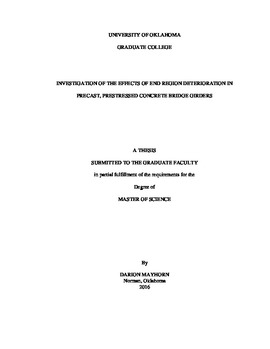| dc.description.abstract | An important factor in life expectancy of concrete bridges is the effect of corrosion of reinforcing steel on concrete and appurtenant embedded materials. New bridges, though continuously exposed to the elements, are expected to last roughly 75 years. Particularly important for aging infrastructure is determining methods to rehabilitate a structure where complete replacement may not be a feasible option. This research is intended to build on the current body of knowledge surrounding corrosion related deterioration of prestressed concrete girders due to extreme environments. Nine prestressed half-scale AASHTO Type II girders were constructed that replicated girders from a bridge recently taken out of service (from I-244 in Tulsa County), which was representative of a large number of aging bridges in the state of Oklahoma. Two different girder designs, corresponding to the different prestressing strand configurations used in the original bridge were utilized. One end region of each girder was exposed to a corrosion accelerant process, and three different exposures were used to illustrate varying environmental conditions. The end regions of six girders were shear tested, after damage by corrosion, to provide an understanding of the effects of end region deterioration on strand anchorage and shear capacity. Measured shear values were less than the nominal design shear capacity (ACI and AASHTO LFRD 2007 methods) for each girder. All of the girder ends that had been exposed to the corrosive environment had a larger measured shear than the control end, except for one girder (C2). Of the six shear tests on the corroded end of the girders, four resulted in slip of the prestressing strands prior to the initial crack of the beam. For the control end of the girders, all six shear tests illustrated cracking of the girder prior to the initiation of slip.
Concurrently with the lab experiments, this research included visiting and inspecting similar bridges as those used in the design for the lab experiment (prestressed concrete bridges with AASHTO Type II girders) to identify varying levels of deterioration due to corrosion. Over the course of 19 site visits, the following deterioration characteristics were identified: corroded bearing plates; corroded anchor bolts and nuts; spalling above the support; exposed rebar and prestressing strands; diagonal cracking of the back corner of the girder; vertical cracking along the girder and diaphragm interface; diagonal cracking from the top flange and web interface; and diaphragm deterioration. Together, the observations from the field inspections and the lab experiments were used to analyze existing retrofit methods and determine recommendations for in-situ rehabilitation for varying levels of deterioration.
While the research does not provide a final solution, the results are expected to provide more breadth in our understanding of prestressed concrete, shear design, effects of corrosion and methods to rehabilitate aging infrastructure. | en_US |
